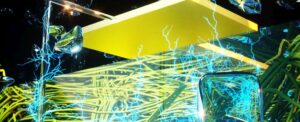New Star Trek-style device ‘harvests clean energy out of thin air’
Sun 9:54 am +01:00, 28 May 2023- Portable device traps humid air, forming small, man-made thunderclouds
- Researchers compare their tech to harvesting ‘electricity from lightning’
Matthew Phelan – Daily Mail May 24, 2023
Just like the replicator on Star Trek: The Next Generation, a new clean energy prototype promises to work wonders out of thin air.
The researchers call it Air-gen, a mobile electricity generation device that uses a network of protein nanowires to turn the ambient humidity in the air into contained, synthetic thunderstorms.
This ‘human-built, small-scale cloud,’ these scientists said, can produce electricity ‘predictably and continuously’ in a wider variety of conditions than sun-dependent solar cells or wind-dependent turbines.
The team hopes to see Air-gen scaled up for mass use across the world – in environments ranging from the Amazon rainforest to the Sahara.
‘The air contains an enormous amount of electricity,’ according to the study’s senior author, Dr. Jun Yao of Massachusetts University Amherst. ‘Think of a cloud, which is nothing more than a mass of water droplets.’
‘Each of those droplets contains a charge, and when conditions are right, the cloud can produce a lightning bolt,’ Dr. Yao said, ‘but we don’t know how to reliably capture electricity from lightning.’
Yao’s Air-gen solves this problem by replicating the conditions of energy-rich thunderclouds, trapping that charged water vapor inside a network of tiny, nano-scale pores.
Luckily, Yao said, a lot of different materials can be used to harvest energy from this technique.
‘It just needs to have holes smaller than 100 nm (nanometers) – or less than a thousandth of the width of a human hair.’
In fact, when his team first started testing this technology three years ago, they used a specialized material of protein nanowires generated from a bacterial culture of Geobacter sulfurreducens.
Essentially, Yao and his team confirmed that they could continuously harvest electricity off a petri dish using their ‘Air-gen effect.’
The 100 nm-size is so important to the process, the team says, because it scales to what chemists know as the ‘mean free path’ – the distance a single molecule of water vapor can float in midair before it bumps into another.
With these tiny pores, the researchers realized that they could create a build-up of electrical charge as water molecules passed through their nanotubes. The effect is almost like balloons generating static electricity, if they were forced to pass through a tube made of thick carpeting.
The Air-gen system creates a charge imbalance, in essence, as the upper end of the pore system builds up a charge in contrast to the lower end, just like the two sides of a battery.
‘The idea is simple,’ Yao said, ‘but it’s never been discovered before – and it opens all kinds of possibilities.’











